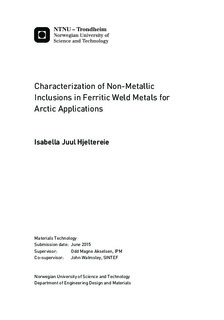Characterization of Non-Metallic Inclusions in Ferritic Weld Metals for Arctic Applications
Master thesis
Permanent lenke
http://hdl.handle.net/11250/2350340Utgivelsesdato
2015Metadata
Vis full innførselSamlinger
Sammendrag
In Arctic applications, structural steel weldments will be subjected to low temperatures, in the worst cases approaching -60 °C. This may be a major challenge, due to the ductile to brittle transition taking place at certain temperature below 0 °C. Thus, the fracture toughness and the use of commercial wires will be of major concern. One factor influencing the weld metal toughness is the microstructure, which again may be dependent on the non-metallic inclusions entrapped in the weld metal.
The main objective in the present work is to characterize the weld metal microstructure and determine the characteristics of the non-metallic inclusions. Three welds were investigated using optical microscopy, scanning electron microscopy and transmission electron microscope to decide the type, chemical composition and size distribution of the inclusions and eventual orientation relationships with the surrounding matrix.
Results from investigating the specimens in optical microscope revealed that specimen 2.1 has the highest fraction of acicular ferrite, while specimen 3.1 consists mainly of bainite and specimen 5.2.1 is a mixture of several microstructures. Examination in the micro probe showed that the non-metallic inclusions had either high titanium or aluminum content, and it seems to have an effect on the amount of acicular ferrite in the weld metal. In addition the inclusions contained oxygen, nitrogen and manganese, which seem to have had a positive effect on the microstructure, since increased content of these elements showed larger amounts of acicular ferrite. Specimen 2.1 and 5.2.1 had both larger and more inclusions than specimen 3.1 when the size distribution of the inclusions was measured.
In the fracture surface appearance of specimen 2.1 and 5.2.1 had both a large ductile crack growth before the brittle fracture occurred. Specimen 3.1 showed nearly no plastic deformation before fracture, indicating a brittle microstructure.
Results from the chemical analysis in the TEM show that the inclusions in specimen 2.1 consist of a titanium oxide core and the surrounding edge composed of manganese sulphide and a complex oxide. Specimen 3.1 has a high aluminum content consisting together with oxygen or nitrogen. Specimen 5.2.1 consisted of complex inclusions with aluminum, manganese, silicon and oxygen. One inclusion in specimen 2.1 was indexed and it indicated an orientation relationship to the surrounding matrix. The exact chemical composition of the same inclusion was also confirmed.
